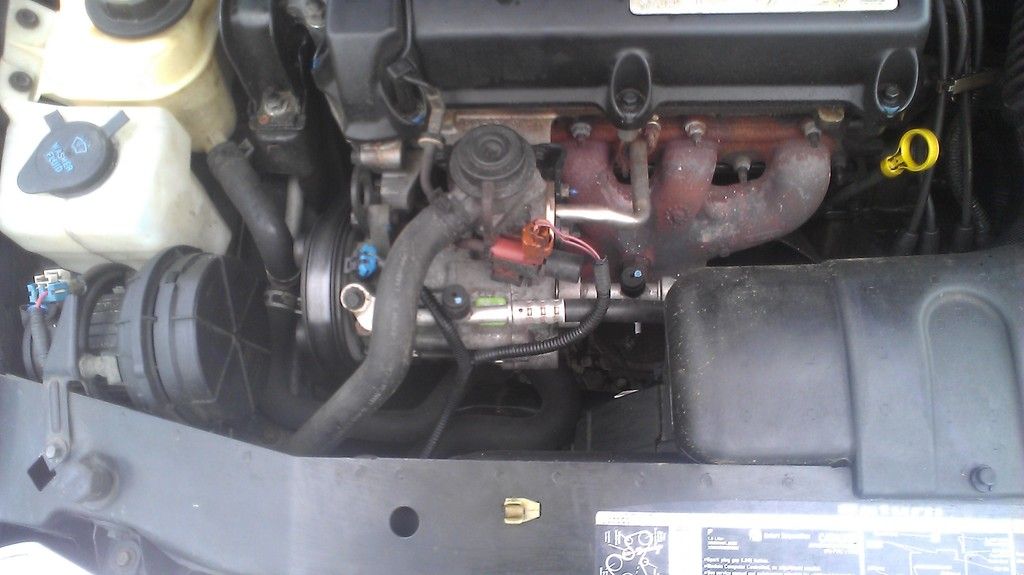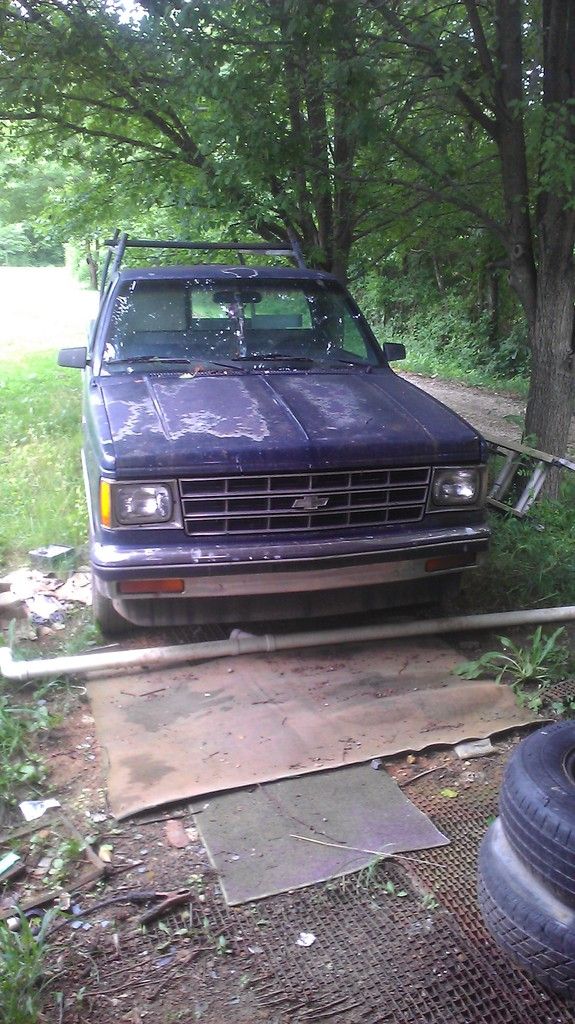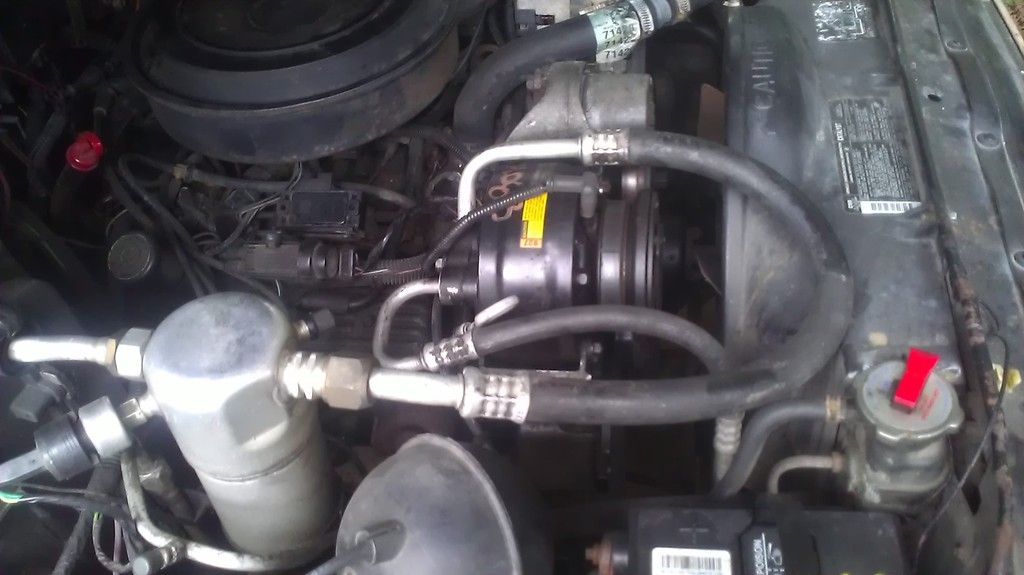
 |
|
Advanced Search | |||||||
 |
|
|
Thread Tools | Display Modes |
|
|
#31 |
|
Administrator
Join Date: Aug 2008
Location: Germantown, WI
Posts: 5,525
Thanks: 1,162
Thanked 374 Times in 305 Posts
|
I checked car-part.com and it isn't showing any salvage yards that stock that A/C line. I'm guessing its one of those things they just don't save. A new one is $115 shipped, so I guess thats way I'm going. The copper line idea is nice, but the automotive world uses bolted together connections with o-rings. I'm not sure how I'd adapt to that sort of fitting.
Yeah, the pump is a rental, and the rental is even free. You basically buy the tool at full price with the intent to return it for a full refund. I just had to buy some vacuum pump oil with it. I believe all autozones do this. Thanks for the help guys!
__________________
Current project - To view links or images in signatures your post count must be 0 or greater. You currently have 0 posts. To view links or images in signatures your post count must be 0 or greater. You currently have 0 posts. & To view links or images in signatures your post count must be 0 or greater. You currently have 0 posts. |
|
|

|
|
|
#32 | |
|
Supreme EcoRenovator
Join Date: Mar 2009
Location: Portland, OR
Posts: 4,004
Thanks: 303
Thanked 723 Times in 534 Posts
|
Quote:
I have found that in the world of auto parts, the greater the level of organization, the higher the price. The level of organization from higher to lower is:
So, you can't call a You-Pull-It yard to see if they have the part, because they do not know. But you can go to one, and find the part and pay maybe $15 or less. With the money you save, you could buy your own vacuum pump. -AC
__________________
I'm not an HVAC technician. In fact, I'm barely even a hacker... Last edited by AC_Hacker; 08-13-14 at 10:48 AM.. |
|
|
|

|
|
|
#33 |
|
Supreme EcoRenovator
|
It's a gm car. I got an alternator for my Saturn out of an s10. 30 bucks.
|
|
|

|
|
|
#34 |
|
Administrator
Join Date: Aug 2008
Location: Germantown, WI
Posts: 5,525
Thanks: 1,162
Thanked 374 Times in 305 Posts
|
I got the new line for the car, but I had to give him the car back for a while. I'll get back to this eventually.
__________________
Current project - To view links or images in signatures your post count must be 0 or greater. You currently have 0 posts. To view links or images in signatures your post count must be 0 or greater. You currently have 0 posts. & To view links or images in signatures your post count must be 0 or greater. You currently have 0 posts. |
|
|

|
|
|
#35 |
|
Administrator
Join Date: Aug 2008
Location: Germantown, WI
Posts: 5,525
Thanks: 1,162
Thanked 374 Times in 305 Posts
|
No updates on this. I still haven't swapped cars back with the other owner.
__________________
Current project - To view links or images in signatures your post count must be 0 or greater. You currently have 0 posts. To view links or images in signatures your post count must be 0 or greater. You currently have 0 posts. & To view links or images in signatures your post count must be 0 or greater. You currently have 0 posts. |
|
|

|
|
|
#36 |
|
Administrator
Join Date: Aug 2008
Location: Germantown, WI
Posts: 5,525
Thanks: 1,162
Thanked 374 Times in 305 Posts
|
I'll be attempting this repair again tomorrow morning. I have the new line and I'll be installing it, pumping down the system, and then charging it back up.
I have two questions for you guys. How long would you pump it down? I'll be using a 1.8 CFM pump thats shown below. After that, how long should I let it sit to see if its leaking? I only have the manifold gauge set also shown below, no micron gauge.
__________________
Current project - To view links or images in signatures your post count must be 0 or greater. You currently have 0 posts. To view links or images in signatures your post count must be 0 or greater. You currently have 0 posts. & To view links or images in signatures your post count must be 0 or greater. You currently have 0 posts. |
|
|

|
|
|
#37 | |
|
Supreme EcoRenovator
Join Date: Mar 2009
Location: Portland, OR
Posts: 4,004
Thanks: 303
Thanked 723 Times in 534 Posts
|
Quote:
Deep vacuum is used to remove air from the system before you introduce refrigerant. Of no less importance, deep vacuum lowers the pressure so that any moisture that could be in the system will 'boil' off. Removing the air will not take very long, because you have a small system. So, maybe 10 or 15 minutes would remove the air, if all your hoses are properly attached, and your pump is working at its best an you have fresh vacuum pump oil (which you will not know for sure without a micron gauge). When you continue vacuuming, you will give the water in the system the chance to boil off. I'd go at least 1 hour total, vacuum pumps are built for this very thing. Not having a micron gauge makes things difficult, because the 'boil off' part happens at maybe 300 microns and lower (which you will not know for sure without a micron gauge)... As to the leak thing, your manifold gauge will only be able to tell you of the very, very large leaks. Another part of this whole procedure, is that the hoses on most manifold gauge sets are not designed to resist the migration of various atmospheric molecules (air) when you have pulled a deep vacuum. But you can get a 'BLACK' vacuum hose that is. You can also get a length of soft copper tube and make a vacuum hose. You can also just use you manifold set and think positive thoughts. I believe that a proper vacuum hose is superior to positive thoughts. In my opinion, you are flying blind without a micron gauge... So, I would say just vacuum it down for an hour, then gas it up, and drive it around. If it holds, you won. If it doesn't hold, do it again. I vacuumed my brand new $1250 mini-split, and I had as much experience as you do right now. I vacuumed it down with a borrowed vacuum pump ("I know that this one works really good"). I used it as is ("The oil is OK, I haven't used the pump since I did Mom's car last year."). I did use assembly lube (AKA: "snot"), and I used a real torque gauge and observed torque specs. About a year later, I became much more aware of proper procedures, and had purchased a micron gauge. I tested the borrowed vacuum pump with my new gauge, and it could only pull 900 microns. I changed the oil and it could pull 650 microns. In other words, the oil was shot, and the vac pump was shot. I wouldn't recommend such sloppy procedures to anyone. Somehow, my mini-split is still working. Beginner's luck, I guess. -AC P.S.: The vacuum pump I have now is a cheap Chinese pump I got from Harbor Freight. It looks a lot like yours. With new oil, and a copper vacuum line, it will pull about 70 microns.
__________________
I'm not an HVAC technician. In fact, I'm barely even a hacker... |
|
|
|

|
| The Following User Says Thank You to AC_Hacker For This Useful Post: | Daox  (06-19-15) (06-19-15) |
|
|
#38 |
|
Supreme EcoRenovator
|
Best thing to do is charge the system with inert gas. Dry nitrogen is standard, mig or tig welding gas (argon, helium, CO2/argon blend) will work. Charge to 200 psi or so. Let it sit an hour, check pressure. If there is more than a molecular leak, you will notice. Pulling a vacuum, there is only around 15 psi difference on the lines and seals. A molecular leak will show up with a micron gauge in an hour or two in a car. Without one, a whole lot more air has to leak in to make the gauge set move off zero.
I used a compressor out of a dehumidifier for a vacuum pump on my last 2 victims: Victim #1 - the sleeper:  2003 Saturn SC2 3 door coupe: last year before they turned it into the ION, then the COBALT, then 13 other cars. Previous owner had problems with the AC, having to recharge every couple of years. Didn't really have to troubleshoot this one; when I opened the hood, the problem was evident.  The Fitting next to the pulley on the compressor had old rubber seals that were weeping. This single fitting houses both suction and discharge lines, and holds them against the compressor body with a single (black) bolt. If you look at the compressor, it gets darker from right to left. By the time you reach the side where the fitting is, the compressor body is a dark army green color. Obviously some of the super frosty freeze medic in a can had some leak detector dye in it. I released pressure on the system, changed the two rubber o-ring seals, and pressure tested the system. No pressure drop, so it got vacuumed and plain jane r134a went back in. Now, when I am on the highway, I don't even need to run the AC. The newer cars auto-cycle the compressor every minute for a bump to keep them from locking up from non-use. I crank the dial to full blue, and out comes cool air. At stoplights, this gimmick doesn't work. Victim #2 - The worthless truck everyone has to try to buy from me:  My brother-in-law parked this truck in my driveway because it would only run for a few minutes at a time. 800 dollars later, he gave up on it. The beast sat there for 2 years until he produced a title. Rather than junk it, he signed it over to me, and borrows it from time to time when he needs it. Root cause: ignition module in distributor. I will never part with this truck. Maybe I'll give it to my son. AC compressor was locked up solid: when you hit the button, it chirped and smoked the drivebelt. 30 bucks later at a u-pull-it yard, I had a compressor out of a blazer and the drier in hand. Same deal as the Saturn, but this thing had the black death in it. Had to buy a new cap tube (carspeak = orifice) and some burnout cleaner. Flush, blow through with shop air, brake parts cleaner, and more shop air. Put new compressor and drier in, seal up everything. Vacuum 20 minutes, recharge with argon, let this one sit overnight. Looked good the next day, so it got vacuumed for 45 minutes after releasing the argon. 200 microns looked mighty fine for a 30 year old truck!  Somebody turned up with some cans of freeze-12, so that's what it has in it. Now it gets driven in the summer. Before the AC repair, it never did. |
|
|

|
| The Following User Says Thank You to jeff5may For This Useful Post: | Daox  (06-19-15) (06-19-15) |
|
|
#39 |
|
Administrator
Join Date: Aug 2008
Location: Germantown, WI
Posts: 5,525
Thanks: 1,162
Thanked 374 Times in 305 Posts
|
I got the new A/C line installed in the car, I vacuumed it and it had monstrous leaks. I'm guessing I need to replace the seals / o-rings. I didn't have any o-rings on hand, and ran out of time to go get some. I assume they're just normal o-rings and not anything special, but they were crushed flat and weren't pliable. Can anyone verify that?
__________________
Current project - To view links or images in signatures your post count must be 0 or greater. You currently have 0 posts. To view links or images in signatures your post count must be 0 or greater. You currently have 0 posts. & To view links or images in signatures your post count must be 0 or greater. You currently have 0 posts. |
|
|

|
|
|
#40 | |
|
Supreme EcoRenovator
|
Quote:
You can get an assortment of them at your favorite local auto parts store for less than $5 for a dozen. The blue (neoprene) and green (hsn/hnbr) ones are what you want for R-134a. The old, black ones (nitrile or butyl) were meant for use with mineral oil and R-12 systems. Bring the caps and old o-rings with you: for a couple dollars more, they might have a kit with all the caps and schraeder valves, plus an assortment of the right sizes of o-rings. While you are at the auto parts store, grab some brake parts cleaner or denatured alcohol. Chances are, your system has moisture or other contamination in it. While you have the system open, flush the lines with your choice of the mentioned solvents. Swap out all of the o-rings you can at once, as since a few have failed, the others are not far behind. There is usually a fitting at the drier, one on or near the firewall, and one or two at the condenser that may or may not be the same size. Once you have assembled the new seals and start pulling a vacuum, use the solvent all around the repaired areas to remove any old UV dye. Shine a black light on the areas to make sure there is none left. Later, if you develop any leaks, you don't want to be chasing your tail because of some stale old oil. |
|
|
|

|
 |
|
|